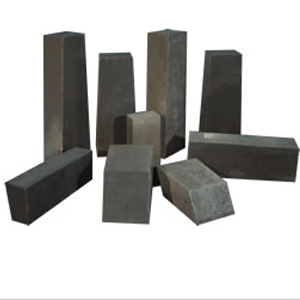When the magnesia carbon brick is in contact with molten steel and slag, the slag corrodes the magnesia carbon brick, which results in poor thermal shock stability of the magnesia carbon brick, spalling damage, shortening the service life of the slag line magnesia carbon brick, and affecting the refining production of the LF furnace. In order to prolong the service life of magnesia carbon bricks, the researchers studied the influence of LF furnace slag on the corrosion resistance of magnesia carbon bricks, and explored ways to extend the service life of magnesia carbon bricks for LF slag line.
Experimental materials and process
Low-iron slag and high-iron slag used in the LF furnace are selected for the experiment, and the composition is shown in the attached table. The magnesia carbon brick is selected from the slag line magnesia carbon brick MT-14 currently used by Angang.
After the researcher made the slag line magnesia-carbon brick into a crucible sample with an inner diameter of ф60mm×50mm and an outer diameter of ф120mm×100mm, the LF low-iron slag and high-iron slag were respectively loaded into the prepared crucible and kept at 1600℃ for 3h , The static crucible method is used to carry out the slag erosion resistance test of magnesia carbon bricks. They grind two kinds of LF furnace slag into 200 mesh fine powder, use thermoplastic phenolic resin as a binder, press it into a cylindrical sample of ф6mm×5mm, put it on the gasket made of slag line magnesia carbon brick, and place it on the slag line magnesia carbon brick gasket. Place it in the refractoriness tester DRH-III to observe the wetting angle between the slag and the magnesia carbon brick when the sample reaches the hemispheric temperature to characterize the wettability of the slag on the magnesia carbon brick.
Experimental results and analysis

Wetting angle detection. According to the schematic diagram of the wetting angle of the two slags of the LF furnace on the magnesia carbon bricks, the researchers calculated that the LF slag with less iron has a wetting angle of 45° for the magnesia carbon bricks, and the LF slag with more iron can wet the magnesia carbon bricks. The wet angle is 58°. It can be seen that both slags of the LF furnace can wet the magnesia carbon bricks, and the slag with less iron wets more obviously, and the erosion of the bricks is more obvious. Therefore, the slag composition of the LF furnace can be adjusted within a certain range, and the wetting angle of the slag to the product can be increased, thereby improving the corrosion resistance of the magnesia carbon brick.
Anti-slag erosion analysis. The SEM morphology of the magnesia carbon brick crucible after the LF slag with less iron and more iron is corroded by the LF slag shows that a thin slag layer is formed on the surface of the magnesia carbon brick after being corroded by the LF slag, and the sample with less iron hangs. The slag layer is relatively obvious. Due to the short erosion time, after being eroded by the two types of slag, the erosion layer on the surface of the magnesia-carbon brick is thin. At the same time, the scaly graphite on the surface of the magnesia-carbon brick in contact with the slag is oxidized, and the matrix is relatively loose. Moreover, the corrosion of low-iron LF slag on magnesia-carbon bricks is significantly stronger than that of high-speed LF slag, and the erosion layer is relatively deep. This is because the low-iron slag has a relatively small wetting angle to the magnesia carbon brick, and the wetting rate of the magnesia carbon brick is fast under the same conditions, thereby accelerating the erosion of the magnesia carbon brick.
The researchers further studied and found that the LF slag first wets the surface of the magnesia-carbon bricks, and then invades the matrix of the magnesia-carbon bricks along the pores left by the oxidation of graphite, fills them around the magnesia particles, and chemically corrodes the magnesia particles. , Generate a low-melting liquid phase containing Ca, Si, Al, thereby gradually encroaching on magnesia particles. It can be inferred from this that as the reaction time is prolonged, a cemented structure will be formed in the magnesia carbon brick, the magnesia particles will be embedded in the liquid phase, and the edges and corners of the magnesia particles will be eroded by the slag and become smooth, thus making the magnesia carbon The composition and performance of the corroded brick layer and the original brick layer, especially the coefficient of thermal expansion, are quite different. When subjected to thermal shock and thermal shock during use, the working surface of the magnesia-carbon brick will be peeled off and damaged. Under the condition of refining outside the LF furnace, due to the high refining temperature, the viscosity of the slag decreases, plus the internal lining The temperature is also higher, and the slag can penetrate deeper into the refractory material to form a thicker reaction layer, which will aggravate the melting loss of the magnesia carbon brick lining and cause serious peeling and chip damage. Therefore, the impact of LF slag on magnesia carbon bricks is mainly manifested in chemical attack and the resulting poor thermal shock stability, and spalling damage.
Ways to extend the life of magnesia carbon bricks for slag line
In summary, the wetting angle of the magnesia-carbon bricks of the two LF furnace slags is less than 90°, which is easy to wet the surface of the magnesia-carbon bricks. When it comes into contact with the magnesia-carbon bricks, the damage rate of the magnesia-carbon bricks will be accelerated, and the iron is low. The wetting phenomenon of LF slag is more obvious. In corrosion experiments, this phenomenon reduces the corrosion resistance of magnesia carbon bricks in contact with low-iron slag.
In order to extend the slag corrosion resistance life of LF furnace magnesia carbon bricks, we can adjust the composition of the slag and increase the wetting angle of the slag to the magnesia carbon bricks. A stable slag layer is formed on the surface of the magnesia carbon bricks to prevent surface graphite. The oxidation of magnesia carbon bricks can inhibit the wetting of the surface of magnesia carbon bricks by molten slag, or by optimizing the matrix structure of magnesia carbon bricks, the introduction form and amount of graphite in the magnesia carbon bricks can be improved, and the ingredients composition of the matrix can be adjusted, thereby affecting the magnesia carbon bricks. During use, the number, size, shape and distribution of pores formed by carbon oxidation will extend the service life of LF slag line magnesia carbon bricks.









